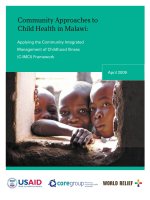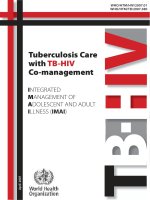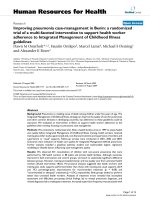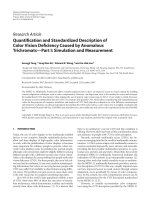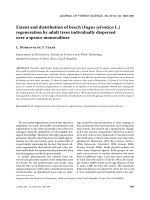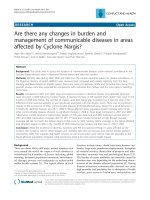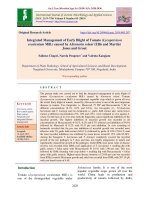Integrated management of stem and root rot of sesame (Sesamum indicum L.) caused by Macrophomina phaseolina (Tassi) Goid
Bạn đang xem bản rút gọn của tài liệu. Xem và tải ngay bản đầy đủ của tài liệu tại đây (150.44 KB, 5 trang )
Int.J.Curr.Microbiol.App.Sci (2019) 8(4): 804-808
International Journal of Current Microbiology and Applied Sciences
ISSN: 2319-7706 Volume 8 Number 04 (2019)
Journal homepage:
Original Research Article
/>
Integrated Management of Stem and Root Rot of Sesame (Sesamum
indicum L.) caused by Macrophomina phaseolina (Tassi) Goid
Nayan Kishor Adhikary1*, Md. Riton Chowdhury1,
Tamina Begum1 and Rambilash Mallick2
1
ICAR- All India Coordinated Research Project on Sesame and Niger, 2Department of
Agronomy, Institute of Agricultural Science, University of Calcutta, 51/2, Hazra Road,
Kolkata-700019, India
*Corresponding author
ABSTRACT
Keywords
Sesame, Stem and
root rot,
Macrophomina
phaseolina,
Incidence,
Management
Article Info
Accepted:
07 March 2019
Available Online:
10 April 2019
Sesame (Sesamum indicum L.) is one of the most ancient oil seed crop cultivated in
tropical and sub-tropical countries. Irrespective of the agro-climate conditions, sesame is
liable to be infected by various pathogenic fungi. Among the fungal diseases, stem and
root rot of sesame caused by Macrophomina phaseolina affects severely at all stages of
crop growth. Macrophomina phaseolina is a diverse, omnipresent soil borne pathogen.
The pathogen survives as sclerotia in the soil and in host tissue for varying periods. Two
consecutive summer season trials of 2017 and 2018 were conducted at Agricultural
Experimental Farm, Institute of Agricultural Science, University of Calcutta, Baruipur,
South 24 Parganas. Integrated management of stem and root rot disease (M. phaseolina) of
sesame was conducted with seven treatments. The results revealed that minimum stem and
root rot incidence (9.5%) and maximum yield (557 kg/ha) with C:B ratio 2.40 in 2017,
stem and root rot incidence (10.5%) and Maximum yield (545 kg/ha) with C:B ratio 2.33
in 2018 were recorded in the treatment of T6 (Seed treatment with carbendazim @ 2 g/kg
+ soil drenching with carbendazim @ 1 g/ l).
apart from cereals. India contributes the
highest sesame acreage of above 17.73 lakh
hectare and production 8 lakh tones and
productivity of 445 kg/ha. The low
productivity is attributed to poor crop
management and exposure of the crop to a
number of biotic and abiotic stresses. India is
the fifth largest vegetable oil economy in the
world, next only to USA, China, Brazil and
Argentina and has an annual turnover of about
Introduction
Sesame (Sesamum indicum L.) rhetorical as
“Queen of oilseeds” is one of the most
important ancient edible oilseed crop grown
in India. Among the oilseed crops, sesame
ranks first for its higher oil content with 6335
kcal kg-1 of dietary energy in seeds (Kumar
and Goel, 1994). Oilseeds are among the
major crops that are grown in the country
804
Int.J.Curr.Microbiol.App.Sci (2019) 8(4): 804-808
Rs. 80,000 crore. India accounts for 12-15%
of oilseeds area, 7-8% of oilseeds production,
6-7% of vegetable oils production, 9-12% of
vegetable oils import and 9-10% of edible oils
consumption (Jha et al., 2014). Sesame seed
is a rich source of protein (20%) and edible
oil (50%) and contains about 47% oleic acid
and 39% linolenic acid (Shyu and Hwang,
2002). Sesame oil has excellent stability due
to the presence of the natural antioxidants
sesamoline, sesamin and sesamol.
1.8 kg yield loss per hectare at every one
percent increase in disease intensity.
At present chemical fungicides are the first
choice to combat diseases because of their
easy adaptability and immediate therapy. Due
to health risk and pollution hazards by use of
chemical fungicides in plant disease control, it
is considered appropriate to minimize their
use. Since sesame seed and oil are in high
demand for export due to their high
unsaturated fat and methionine content, focus
has been shifted out safer alternatives to
chemical fungicides in recent years.
Biological control had attained importance in
modern agriculture to limit the hazards of
intensive use of chemicals for disease control.
Since the efficacy of biocontrol agents in
disease attenuation has been inappropriate due
to their inability to maintain a critical
threshold population necessary for sustained
biocontrol
activity,
biocontrol
with
antagonistic microorganisms alone could not
be a complete replacement for management
strategies currently employed. To enhance
and extend the desired response, the addition
of specific substrates which are utilized
selectively by the introduced microbe
employed as biocontrol agent (Paulitz, 2000).
The area and production of sesame crop is
declining in the traditional areas. Despite the
potential for increasing the production and
productivity of sesame, there are a number of
challenges inhibiting sesame production and
productivity.
The main reason for low productivity of this
crop is due to the attack of various fungal,
bacterial and viral diseases. About 72 fungi, 7
bacteria, 1 phytoplasmal and 1 viral disease
have been reported from India (Vyas et al.,
1984). Out of these, about 32 diseases (14
major and 18 minor) occur in India. The crop
is susceptible to number of fungal diseases,
such as Charcoal rot of sesame (M.
phaseolina), Alternaria leaf spot (Alternaria
sesami),
Powdery
mildew
(Erysiphe
cichoracearum) and Cercospora leaf spot
(Cercospora sesami). Among the fungal
diseases, Charcoal rot caused by M.
phaseolina affects severely at all stages of the
crop growth. The disease is particularly
reported to be quite serious, limiting the
production of crop. High temperature and
water stress during growing season favours
the pathogen’s incidence. Vyas, (1981)
reported M. phaseolina as very serious and
destructive pathogen in all sesame growing
areas and causes 5-100% yield loss while
Maiti et al., (1988) estimated yield loss of
around 57% at about 40% of disease
incidence. Murugesan et al., (1978) observed
Therefore integrated management that
incorporates the biocontrol agents, botanicals
and organic amendments would reduce the
amount of fungicide used per season in
addition to combat diseases in an
economically viable and ecologically safe
proportion.
No much research work is carried out
particularly stem and root rot of sesame
disease in West Bengal. Hence, an attempt
was undertaken to assess the effect of
integrated disease management with different
treatments in respect of disease incidence and
yield of sesame.
805
Int.J.Curr.Microbiol.App.Sci (2019) 8(4): 804-808
viride @ 2.5 kg/ha enriched in 100 kg of
FYM + neem cake @ 250 kg/ha at sowing;
T6: Seed treatment with carbendazim @ 2
g/kg + soil drenching with carbendazim @ 1
g/ l and T7: Untreated check (control) in
randomized block design with three
replications. The incidence of Macrophomina
root rot was recorded individually by
counting the number of affected and healthy
plants at random quadrate selection in each
plot and the percent incidence was calculated.
The grain yield was recorded and C:B ratio
was worked out.
Materials and Methods
Two consecutive summer season trials of
2017 and 2018 were laid down at Agricultural
Experimental Farm, Baruipur, South 24
Parganas, Institute of Agricultural Science,
University of Calcutta with seven treatments
in integrated manner, T1: Seed treatment with
T. viride @ 4 g/kg + soil application of T.
viride @ 2.5 kg/ha enriched in 100 kg of
FYM at sowing; T2: Seed treatment with P.
Flourescens@ 10 g/kg + Soil application of
P. fluorescens @ 2.5 kg/ha enriched in 100 kg
of FYM at sowing; T3: Seed treatment with T.
viride @ 4 g/kg + soil application of T. viride
@ 2.5 kg/ha enriched in 100 kg of FYM +
neem cake @ 250 kg/ha at sowing; T4: Seed
treatment with P. fluorescens @ 10 g/kg +
soil application of P. fluorescens @ 2.5 kg/ha
enriched in 100 kg of FYM + neem cake 250
kg/ha at sowing; T5: Seed treatment with T.
viride + P. fluorescens @ 10 g /kg + Soil
application of P. fluorescens @ 2.5 kg/ha + T.
Results and Discussion
Stem and root rot are caused by M.
phaseolina (Tassi) Goid (Mihail, 1995). The
symptoms were produced at ground level
stem becomes black, which extends upward
rupturing the stem and black dots appear on
the infected stem.
Table.1 Integrated management of stem and root rot disease of sesame caused
by M. phaseolina during summer, 2017
Treatment
T1 : Seed treatment with T. viride @ 4 g/kg + soil application of T.
viride @ 2.5 kg/ha enriched in 100 kg of FYM at sowing.
T2 : Seed treatment with P. flourescens @ 10 g/kg + Soil application
of P. fluorescens @ 2.5 kg/ha enriched in 100 kg of FYM at sowing.
T3: Seed treatment with T. viride @ 4 g/kg + soil application of T.
viride @ 2.5 kg/ha enriched in 100 kg of FYM + neem cake @ 250
kg/ha at sowing.
T4 : Seed treatment with P. fluorescens @ 10 g/kg + soil application
of P. fluorescens @ 2.5 kg/ha enriched in 100 kg of FYM + neem
cake 250 kg/ha at sowing.
T5 : Seed treatment with T. viride + P. fluorescens @ 10 g /kg + soil
application of P. fluorescens @ 2.5 kg/ha + T. viride @ 2.5 kg/ha
enriched in 100 kg of FYM + neem cake @ 250 kg/ha at sowing.
T6 : Seed treatment with carbendazim @ 2 g/kg + soil drenching
with carbendazim @ 1 g/ l.
T7 : Untreated check
S.Em+
CD (5%)
*Figures in parenthesis are angular transformed values
806
Stem and Root
rot (%)
26.3(31.16)
Yield
(Kg/ha)
291
C:Bratio
16.6(24.22)
438
1.89
12.5(21.11)
479
2.06
21.8(27.98)
364
1.57
11.2(19.79)
532
2.29
9.5(18.34)
557
2.40
33.6(35.56)
1.64
5.07
254
4.59
14.14
1.25
Int.J.Curr.Microbiol.App.Sci (2019) 8(4): 804-808
Table.2 Integrated management of root rot disease of sesame caused
by M. phaseolina during summer, 2018
Treatment
T1 : Seed treatment with T. viride @ 4 g/kg + soil application
of T. viride @ 2.5 kg/ha enriched in 100 kg of FYM at sowing.
T2 : Seed treatmen twith P. flourescens @ 10 g/kg + Soil
application of P. fluorescens @ 2.5 kg/ha enriched in 100 kg of
FYM at sowing.
T3 : Seed treatment with T. viride @ 4 g/kg + soil application
of T. viride @ 2.5 kg/ha enriched in 100 kg of FYM + neem
cake @ 250 kg/ha at sowing.
T4 : Seed treatment with P. fluorescens @ 10 g/kg + soil
application of P. fluorescens @ 2.5 kg/ha enriched in 100 kg of
FYM + neem cake 250 kg/ha at sowing.
T5 : Seed treatment with T. viride + P. fluorescens @ 10 g /kg +
Soil application of P. fluorescens @ 2.5 kg/ha + T. viride @ 2.5
kg/ha enriched in 100 kg of FYM + neem cake @ 250 kg/ha at
sowing.
T6 : Seed treatmentwith carbendazim @ 2 g/kg + soil
drenching with carbendazim @ 1 g/ l.
T7 : Untreated check
S.Em+
CD (5%)
Root rot (%)
34.5
(36.26)
23.3
(28.70)
Yield (kg/ha)
277
C:B ratio
1.23
434
1.89
15.8
(23.54)
482
2.10
26.5
(30.94)
358
1.55
13.2
(21.66)
526
2.27
10.8
(19.59)
545
2.33
39.2
(38.87)
2.88
8.86
246
4.39
13.53
*Figures in parenthesis are angular transformed values
It is evident from the table 1 that all
treatments were found to be superior over
untreated check (T7) in reducing the disease
incidence and increasing grain yield and C:B
ratio during summer, 2017. Of which, T6
including
the
seed
treatment
with
carbendazim @ 2 g/kg + soil drenching with
carbendazim @ 1 g/ l was found to be
significantly effective by recording the
minimum incidence of stem and root rot
(9.5%) and higher yield (557 kg/ha) during
summer, 2017.This result is confirmed by the
finding of Chauhan (1988) who observed
good control of M. Phaseolina by seed
treatment with carbendazim. A similar
observation also made by Shumaila and Khan
(2016).
drenching with carbendazim @ 1 g/ l (T6)
followed by disease incidence (11.2%) and
yield 532Kg/ha in the treatment T5 (seed
treatment with T. viride + P. fluorescens @ 10
g /kg + soil application of P. fluorescens @
2.5 kg/ha + T. viride @ 2.5 kg/ha enriched in
100 kg of FYM + neem cake @ 250 kg/ha at
sowing) during summer, 2018.The present
investigation is in line with the report of
Jaiman et al., (2009). With respect to grain
yield, all integrated treatments recorded
significantly higher seed yield than untreated
check (control).
The present work indicated that seed
treatment and soil drenching with fungicide
(carbendazim)
and
seed
treatment,
incorporation of bioagents (enriched in yard
manure and neem cake) in soil are reported a
new information for the management of
sesame stem and root rot disease in South
Bengal condition.
The results exhibited in the table 2, low
disease incidence (10.8%) and higher yield
(545 kg/ha) could be best achieved with seed
treatment of carbendazim @ 2 g/kg + soil
807
Int.J.Curr.Microbiol.App.Sci (2019) 8(4): 804-808
and chlorate utilization. Can. J. Bot. 73:
1596-1603.
Murugesan, M., Shanmugam, N., Menon, P.
P. V., Arokiaraj, A., Dhamo, K. P. and
Kochubabu, M. 1978. Statistical
arrangement of yield loss of sesame due
to insect pests and diseases. Madras
Agric. J. 65: 290-295.
Paulitz, T. C. 2000. Population dynamics of
biocontrol agents and pathogens in soils
and rhizospheres. Eur. J. Pl. Pathol.
106: 401-413.
Shumaila, S., Khan, M. R. 2016. Management
of root rot of mungbean caused by
Macrophomina phaseolina through seed
treatment with fungicides. Indian
Phytopathol. 69 (2): 26-35.
Shyu, Y. S. and Hwang, L. S. 2002.
Antioxidative activity of the crude
extract of lignin glycosides from
unroasted Burma black sesame meal.
Int. Food Res. 35: 357-365.
Vyas, S. C. 1981. Diseases in sesamum in
India and their control. Pesticides.
15:10.
Vyas, S. C., Prasad, K. V. V. and Khare, M.
N. 1984. Diseases of sesamum and
niger in India and their control.
Department of Plant Pathology,
JNKVV, Jabalpur, M. P. Bull. pp.16.
References
Chauhan, M. S. 1988. Relative efficiency of
different methods for the control of
seedling disease of cotton caused by
Rhizoctonia bataticola. Indian J. Mycol.
Pl. Pathol. 18 (1): 25-30.
Jaiman, R. K, Jain, S. C. and Sharma P. 2009.
Field
evaluation
of
fungicides,
bioagents and soil amendments against
root rot caused by Macrophomina
phaseolina in cluster bean. J. Mycol. Pl.
Pathol. 39 (1): 74-76.
Jha, G. K., Pal, S., Mathur, V. C., Bisaria, G.,
Dubey, S. K. 2014. Edible oilseed
supply and demands scenario in India:
Implication of policy, Div Agric
Economics, IARI, New Delhi.
Kumar, S. and Goel, P.D. 1994. A great
ancient oilseed sesamum. Farmers and
Parliament. 12: 6-7.
Maiti, S., Hegde, M. R. and Chattopadhyay,
S. B. 1988. Handbook of Annual
Oilseed Crops. Oxford and IBH Publ.
Co. Pvt. Ltd., New Delhi.
Mihail, J. D. and Taylor, S. J. 1995.
Interpreting variability among isolates
of Macrophomina phaseolina in
pathogenicity, pycnidium production,
How to cite this article:
Nayan Kishor Adhikary, Md. Riton Chowdhury, Tamina Begum and Rambilash Mallick. 2019.
Integrated Management of Stem and Root Rot of Sesame (Sesamum indicum L.) caused by
Macrophomina phaseolina (Tassi) Goid. Int.J.Curr.Microbiol.App.Sci. 8(04): 804-808.
doi: />
808
